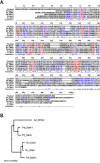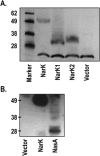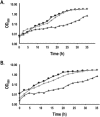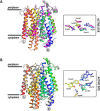The Paracoccus denitrificans NarK-like nitrate and nitrite transporters-probing nitrate uptake and nitrate/nitrite exchange mechanisms
- PMID: 27696579
- PMCID: PMC5217062
- DOI: 10.1111/mmi.13546
The Paracoccus denitrificans NarK-like nitrate and nitrite transporters-probing nitrate uptake and nitrate/nitrite exchange mechanisms
Abstract
Nitrate and nitrite transport across biological membranes is often facilitated by protein transporters that are members of the major facilitator superfamily. Paracoccus denitrificans contains an unusual arrangement whereby two of these transporters, NarK1 and NarK2, are fused into a single protein, NarK, which delivers nitrate to the respiratory nitrate reductase and transfers the product, nitrite, to the periplasm. Our complementation studies, using a mutant lacking the nitrate/proton symporter NasA from the assimilatory nitrate reductase pathway, support that NarK1 functions as a nitrate/proton symporter while NarK2 is a nitrate/nitrite antiporter. Through the same experimental system, we find that Escherichia coli NarK and NarU can complement deletions in both narK and nasA in P. denitrificans, suggesting that, while these proteins are most likely nitrate/nitrite antiporters, they can also act in the net uptake of nitrate. Finally, we argue that primary sequence analysis and structural modelling do not readily explain why NasA, NarK1 and NarK2, as well as other transporters from this protein family, have such different functions, ranging from net nitrate uptake to nitrate/nitrite exchange.
© 2016 The Authors. Molecular Microbiology Published by John Wiley & Sons Ltd.
Figures








Similar articles
-
Interdependence of two NarK domains in a fused nitrate/nitrite transporter.Mol Microbiol. 2008 Nov;70(3):667-81. doi: 10.1111/j.1365-2958.2008.06436.x. Epub 2008 Sep 18. Mol Microbiol. 2008. PMID: 18823285
-
The roles of the polytopic membrane proteins NarK, NarU and NirC in Escherichia coli K-12: two nitrate and three nitrite transporters.Mol Microbiol. 2002 Apr;44(1):143-55. doi: 10.1046/j.1365-2958.2002.02858.x. Mol Microbiol. 2002. PMID: 11967075
-
Two domains of a dual-function NarK protein are required for nitrate uptake, the first step of denitrification in Paracoccus pantotrophus.Mol Microbiol. 2002 Apr;44(1):157-70. doi: 10.1046/j.1365-2958.2002.02859.x. Mol Microbiol. 2002. PMID: 11967076
-
Nitrate and nitrite transport in bacteria.Cell Mol Life Sci. 2001 Feb;58(2):215-24. doi: 10.1007/PL00000849. Cell Mol Life Sci. 2001. PMID: 11289303 Free PMC article. Review.
-
Metabolic regulation including anaerobic metabolism in Paracoccus denitrificans.J Bioenerg Biomembr. 1991 Apr;23(2):163-85. doi: 10.1007/BF00762216. J Bioenerg Biomembr. 1991. PMID: 2050653 Review.
Cited by
-
Transcriptional and translational adaptation to aerobic nitrate anabolism in the denitrifier Paracoccus denitrificans.Biochem J. 2017 May 10;474(11):1769-1787. doi: 10.1042/BCJ20170115. Biochem J. 2017. PMID: 28385879 Free PMC article.
-
A dual functional redox enzyme maturation protein for respiratory and assimilatory nitrate reductases in bacteria.Mol Microbiol. 2019 Jun;111(6):1592-1603. doi: 10.1111/mmi.14239. Epub 2019 Apr 6. Mol Microbiol. 2019. PMID: 30875449 Free PMC article.
-
Partnered Excited-State Intermolecular Proton Transfer Fluorescence (P-ESIPT) Signaling for Nitrate Sensing and High-Resolution Cell-Imaging.Molecules. 2022 Aug 13;27(16):5164. doi: 10.3390/molecules27165164. Molecules. 2022. PMID: 36014404 Free PMC article.
-
Mechanisms underlying the low-temperature adaptation of 17β-estradiol-degrading bacterial strain Rhodococcus sp. RCBS9: insights from physiological and transcriptomic analyses.Front Microbiol. 2024 Nov 21;15:1465627. doi: 10.3389/fmicb.2024.1465627. eCollection 2024. Front Microbiol. 2024. PMID: 39640852 Free PMC article.
-
Nutrient Limitation Causes Differential Expression of Transport- and Metabolism Genes in the Compartmentalized Anammox Bacterium Kuenenia stuttgartiensis.Front Microbiol. 2020 Aug 13;11:1959. doi: 10.3389/fmicb.2020.01959. eCollection 2020. Front Microbiol. 2020. PMID: 32903544 Free PMC article.
References
-
- Abramson, J. , Smirnova, I. , Kasho, V. , Verner, G. , Kaback, H.R. , and Iwata, S. (2003) Structure and mechanism of the lactose permease of Escherichia coli . Science 301: 610–615. - PubMed
-
- Abramson, J. , Iwata, S. , and Kaback, H.R. (2004) Lactose permease as a paradigm for membrane transport proteins. Mol Membr Biol 21: 227–236. - PubMed
-
- Alefounder, P.R. , Mccarthy, J.E.G. , and Ferguson, S.J. (1981) The basis of the control of nitrate reduction by oxygen in Paracoccus dentrificans . FEMS Microbiol Lett 12: 321–326.
-
- Boogerd, F.C. , Vanverseveld, H.W. , and Stouthamer, A.H. (1983) Dissimilatory nitrate uptake in Paracoccus denitrificans via a ‐dependent system and a nitrate‐nitrite antiport system. Biochim Biophys Acta 723: 415–427.
MeSH terms
Substances
Grants and funding
LinkOut - more resources
Full Text Sources
Other Literature Sources
Molecular Biology Databases

